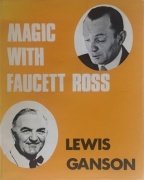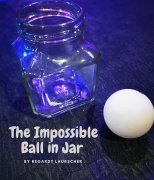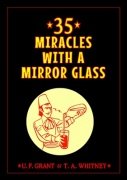Reviews: Read What David Nethery Is Saying
1 ★★★★★ reviews
1 ★★★★★ reviews
The Elusive Canary
Overall customer rating: ★★★★★reviewed by David Nethery (confirmed purchase)
Rating: ★★★★★ (Date Added: Tuesday 11 February, 2025)
 This book, The Elusive Canary - (The Vanishing Bird Cage) The Last Word In Cages by Mystic Craig (with assistance from Jean Hugard) has long been somewhat elusive itself. The book was originally self-published in 1936 and sold for $2.00. Today in 2025 it is not unusual to see a copy going for $65 or more. Many thanks to Lybrary.com for making it available. Mystic Craig's real name was William M. Vagell.
This book, The Elusive Canary - (The Vanishing Bird Cage) The Last Word In Cages by Mystic Craig (with assistance from Jean Hugard) has long been somewhat elusive itself. The book was originally self-published in 1936 and sold for $2.00. Today in 2025 it is not unusual to see a copy going for $65 or more. Many thanks to Lybrary.com for making it available. Mystic Craig's real name was William M. Vagell.
Those magicians who have a particular interest in the classic effect, The Vanishing Bird Cage, will be the primary audience for this book. I for one am glad to have access to this rare book as an e-book edition through Lybrary.com. For what it is as a historical piece , I'm rating this book 5-stars, but potential buyers should be aware that it is a slender volume (23 pages) and the subtitle: “The Last Word On Cages” is a bit of an exaggeration on the part of the author. It is not a comprehensive treatment on all the various methods and types of vanishing bird cages that had been used from the time of Buatier De Kolta (the inventor of the effect) to the time when the book came out (in 1936). It is mostly the author's own particular handling for the effect and a few novel ideas he had for enhancing the effect. Although, at the time (and in the years since then) you could almost say it was the ONLY word on the vanishing bird cage, as very little detailed information has ever been put into print on this delightful, but difficult to perform feat of magic. Most information on performing the vanishing bird cage effect -- the 'real work' on the cage -- has been passed along in person from magician to magician or in the occasional article published in magazines such as Linking Ring or M-U-M. In the present day I would say “the last word on cages” is to be found in John Carney’s outstanding book Sleights and Insights in his chapter on 'The Vanishing Bird Cage Revisioned', which at 27 pages is longer than The Elusive Canary. John Carney also covers much of the same material from his book Sleights and Insights in a video tutorial which is also titled 'The Vanishing Bird Cage Revisioned'. (Available to purchase from John Carney on his website)
At any rate, I appreciate Mystic Craig’s book The Elusive Canary , even if it falls a bit short of being “THE Last Word On Cages”. It contains some valuable information on the vanishing bird cage, so for the vanishing bird cage aficionado I would recommend it as a historical curiosity worth reading. It is rumored that master craftsman James P. Riser (whose vanishing bird cages are regarded as among the best ever made) has a book in the works about The Vanishing Bird Cage, which, if he ever publishes it, may likely be The Last Word On Cages.
Magic with Faucett Ross
Overall customer rating: ★★★★★reviewed by David Nethery (confirmed purchase)
Rating: ★★★★★ (Date Added: Wednesday 10 July, 2024)
 The content of this book gets FIVE STARS. It's a great, classic book, full of practical material and some interesting historical tidbits about famous magicians who Faucett Ross befriended and rubbed elbows with (Dai Vernon, T. Nelson Downs, etc.)
The content of this book gets FIVE STARS. It's a great, classic book, full of practical material and some interesting historical tidbits about famous magicians who Faucett Ross befriended and rubbed elbows with (Dai Vernon, T. Nelson Downs, etc.)
I would probably rate this edition lower in terms of the quality of the photos in the e-book edition. I had this book for many years in hard copy form, the original book as published by Supreme Magic Co. (alas, I no longer have that hard copy, but am seeking out another) and I remember the quality of the photos being much better. The original book's photos were not exactly high-resolution photos by modern standards, but pretty good. The scanned photos in this e-book look harsh and low-resolution. It's difficult in some of the scanned photos to tell what it is you're supposed to be seeing. I know because I had the book at one time, but for someone seeing this book the first time in e-book form they may find some of the photos difficult to understand.
Aside from that I would highly recommend this book.
Impossible Ball in Jar
Overall customer rating: ★★★★★reviewed by David Nethery (confirmed purchase)
Rating: ★★★★★ (Date Added: Thursday 19 October, 2023)
 This caught my attention because I was looking for a method to pass a ball into a jar or bottle, so on an impulse I took a chance on this trick. It turns out to have some weaknesses. I'm sort of embarrassed that I didn't watch the video several times and more carefully consider those weaknesses before I paid $10 for this single trick (there are whole books with dozens of tricks on Lybrary.com for $10 ... I should have stuck with buying a book). The biggest weakness is that you are required to use a draped table and a hat (although an alternative handling using a change bag is given. If you don't have objections to using a change bag, it is ok.) The author says he has done it just using a suitcase table instead of a draped table.
This caught my attention because I was looking for a method to pass a ball into a jar or bottle, so on an impulse I took a chance on this trick. It turns out to have some weaknesses. I'm sort of embarrassed that I didn't watch the video several times and more carefully consider those weaknesses before I paid $10 for this single trick (there are whole books with dozens of tricks on Lybrary.com for $10 ... I should have stuck with buying a book). The biggest weakness is that you are required to use a draped table and a hat (although an alternative handling using a change bag is given. If you don't have objections to using a change bag, it is ok.) The author says he has done it just using a suitcase table instead of a draped table.
I can't recommend this trick.
Victory Bouquet
Overall customer rating: ★★★★★reviewed by David Nethery
Rating: ★★★★★ (Date Added: Thursday 30 December, 2021)
 An essential reference for making spring flowers. This booklet covers Martineau's method of making a large bouquet (complete with long stems) of spring flowers, but this book would also be enormously useful to anyone wanting to make individual spring flowers for the traditional Flowers from Paper Cone production. Martineau gives you precise instructions, with very clear illustrations, on how to make the flowers. If you know Martineau's illustrations from the Rice Encyclopedia of Silk Magic then you will know how precise his drawings are.
An essential reference for making spring flowers. This booklet covers Martineau's method of making a large bouquet (complete with long stems) of spring flowers, but this book would also be enormously useful to anyone wanting to make individual spring flowers for the traditional Flowers from Paper Cone production. Martineau gives you precise instructions, with very clear illustrations, on how to make the flowers. If you know Martineau's illustrations from the Rice Encyclopedia of Silk Magic then you will know how precise his drawings are.
Spring Flowers have really become a do-it-yourself project for anyone who wants decent-looking blooms that halfway resemble real flowers (from a distance). These are not difficult to make once you understand the proportions and the steps for constructing them, but they are very time consuming to produce (and to make a decent looking production you need at least 50) so the days of purchasing good looking pre-made spring flowers from a magic dealer have passed. You'll have to rely on your own craftiness and the investment of your own time. Almost all of the pre-made spring flowers you can obtain from a magic supplier these days are made cheaply in India and they don't look very good, most don't even attempt to look like real flowers (the worst offenders being the "flowers" that are made from metallic-looking mylar. What those are intended to resemble I have no idea, but they sure don't look like flowers.) By combining the construction techniques that Martineau covers (either for individual blooms or a whole bouquet with long stems) along with adding some tasteful stippling on the inner part of the flowers and stippling along the outer edges of the flowers using colored Sharpie markers, or PrismaColor or Copic Markers, you can increase the resemblance of the blooms to real flowers (you can also brush on colored dye with a slightly wet watercolor brush on the edges of the blooms which can yield some interesting color bleed gradients --- experiment!) Another good option is to obtain some of the artificial flowers made from thin fabric at a craft store and use those to construct your spring flowers, instead of using the traditional tissue paper. The fabric flowers will tend to be a bit thicker than the paper flowers so that's something to consider in terms of the size of the load, but the fabric flowers (and green leaves) look realistic from a very short distance.
One bit of advice that is often forgotten when using spring flowers is the ratio of green leaves to colored blooms: it should be a ratio of 50 - 50, or some say 60 - 40 (that is for every 4 colored blossoms you would include 6 all green, or at least for every 5 colored blooms include 5 all green). Also, it tends to look better to have each bouquet or batch of spring flowers produced to be all one color, for example, all-white blooms, or all pink, or all red, all yellow, instead of mixing in multiple colors like red, yellow, purple, orange, blue, white, green. Or vary it by having mostly white blooms, but a few pink dropped in the mix. (again, keeping the proportion of all green leaves higher than the number of colored blooms) If you want to see how good this can look search out a video of French magician Dani Lary performing his act "The Magical Gardener".
35 Miracles with a Mirror Glass
Overall customer rating: ★★★★★reviewed by David Nethery (confirmed purchase)
Rating: ★★★★★ (Date Added: Thursday 13 August, 2020)
 This is a useful reference book on various uses for this classic prop. I would recommend it.
This is a useful reference book on various uses for this classic prop. I would recommend it.
Something that would improve this e-book would be to update it with recommended sources to purchase a good well-made tumbler or goblet that has been gimmicked in this way. Sadly, there are many cheap, poorly made versions available, but not many good ones. Most of the models currently available are not very deceptive looking; these cheap versions use a plastic glass and a piece of polished metal (a highly polished piece of stainless steel can be very effective, but many of the cheaper glasses on the market don't use highly polished stainless steel.) One of the common mistakes made in these type of glasses (both older models and current models) is to have the edge of the gimmick extend to the very top edge of the tumbler. This makes it too likely that the edge will flash at some point without very careful handling. The best versions are made in such a way that the top edge of the gimmick is lower than the edge of the glass. Some types of acrylic or lucite tumblers or goblets are appropriate for making this prop, but it's hard to beat the use of a heavy, fluted real glass for disguising the presence of the gimmick. Even if some good versions of this prop could be recommended for purchase, magic props tend to come and go - example: a few years ago there was an excellent version made by Steve Dick called the "Diamond Cut M***** Goblet" , but this has been discontinued and is hard to find - so perhaps another valuable way to update this e-book would be to include instructions on how to make your own, with suggestions for appropriate types of heavy fluted glasses or glasses with a "diamond" or "waffle" cut pattern that could be used (antique markets or websites dealing in antique glassware are a good source), also the right kind of material that can be used to make the gimmick. Many of the effects with this kind of glass use a gimmick that is removable, but it would also be useful to provide instruction on how to permanently mount the gimmick with the right kind of clear-drying waterproof adhesive for effects that involve the use of liquid. Some of this may be covered (?) in the e-book Magician's DIY Tips and Tricks by Chris Wasshuber also available here on Lybrary.com, which I don't own (yet), but if not then a section on how to make this sort of prop might be a worth addition to 'Magician's DIY Tips and Tricks' as well.
U. F. Grant's Lost Illusion Secrets Revealed
Overall customer rating: ★★★★★reviewed by David Nethery (confirmed purchase)
Rating: ★★★★★ (Date Added: Tuesday 02 June, 2020)
 I’m an admirer of the creative genius of U.F. Grant, so I was hoping to get more out of viewing the “Missing Files” of “U. F. Grant's Lost Illusion Secrets Revealed”, but I would have to say this PDF is way over-priced for what it is. $5.00 might be a fair price, but $35.00 is too much. The description of this PDF file says:
I’m an admirer of the creative genius of U.F. Grant, so I was hoping to get more out of viewing the “Missing Files” of “U. F. Grant's Lost Illusion Secrets Revealed”, but I would have to say this PDF is way over-priced for what it is. $5.00 might be a fair price, but $35.00 is too much. The description of this PDF file says:
“Over the years, Grant sold many manuscripts that just contained one illusion along with building plans in most cases. (Some of these were released by Percy Abbott in his catalog without credit to U. F. Grant.) This compilation is a collection of those plans released by Grant and also in the early Abbott Magic catalogs.
Most of these plans are near impossible to find nowadays and most of the ideas and plans will be new to the majority of magicians. The manuscripts have new typeset, corrected errors and added photos.”
Several of the illusions described have no plans or illustrations at all, most have only a few crude sketches that get the basic idea across, but offer little practical guidance on how you would actually build or perform these illusions. Some do have plans with actual dimensions given, but overall the building directions are sparse.
The description -- “The manuscripts have new typeset, corrected errors and added photos” -- gave me the impression that these various old plans and ideas had been substantially edited and updated with the addition of photo illustrations of the illusions, but the “added photos” are simply a few generic stock photos found on the internet:
- On page 18 a stock photo (with the 123rf.com watermarks still visible ... you're supposed to pay the licensing fee if you use stock images) of a girl with a towel wrapped around her for “The Girl in the Shower” illusion, but this stock photo has nothing specifically to do with the Grant illusion, it’s just a cheesecake photo of a pretty girl with a towel around her.
- On page 112 a stock photo of Santa Claus accompanies the “Santa Claus Arrives” illusion, but again this stock photo has nothing to do with illustrating how the illusion would look or how to build it, it’s simply a stock photo of Santa Claus.
- On page 142 there is a photo of a child’s rubber boot, in connection with the “Farmer and the Witch” illusion where it says: “Some performers who are using this illusion have made cloth ‘boots’ to match the costumes, In the event that the audience should get a glimpse of the feet of the children, the shoes will not give the illusion away. Instead of the cloth boots, you could use the cheap plastic boots which are sold for children in the winter time.”
- On page 143 a stock photo of a surgeon and a nurse in surgical masks is printed at the start of the description for “The Doctor and the Nurse Illusion”.
- On page 165 for “The Bunny-Girl Illusion” a stock photo of a girl in a sort of "Playboy Bunny" type of costume grabbed from a Halloween store website. It has nothing to do with the illusion, except the suggestion that “The girl should, of course, be dressed in the popular bunny costume — bunny ears, white collar and cotton tail.”
- On page 167 a photo of the “Girl on Three Swords Illusion”, but it’s simply a photo of the prop as seen by the audience at the start of the illusion, three swords standing upright on a small platform. There is no description or photo of how to make the gimmick.
None of the 6 stock photos included are of any use in helping someone to build or perform the illusions described, so the mention in the description of “added photos” as a selling point is rather misleading.